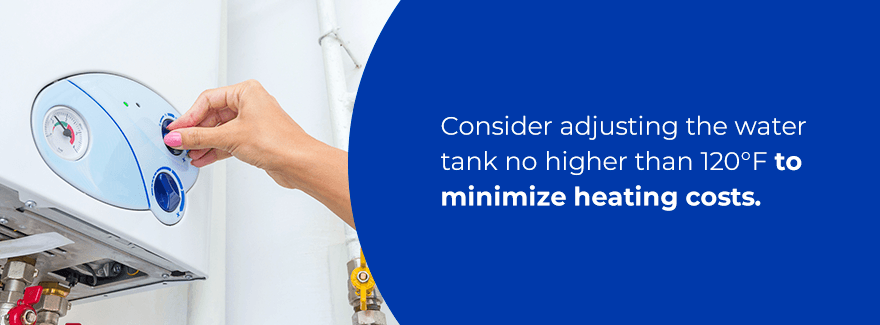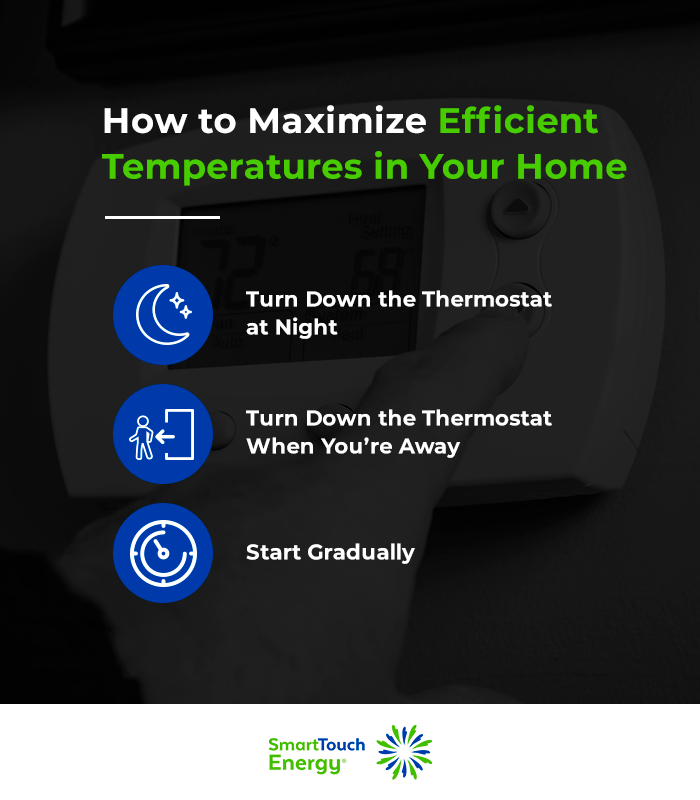
Winter energy bills can send us running for cover. Specifically blanket covers, because it's cold and because we want to hide from the number on our statement.
- What's the Ideal Temperature for a House in Winter?
- How to Maximize Efficient Temperatures in Your Home
- How Much Can I Save By Turning Down My Heat in Winter?
- How Can I Reduce Heating Costs in the Winter?
- Reduce Your Home's Winter Heating Costs
Sound familiar? What if instead of crossing your fingers when receiving that inevitable energy bill, you found ways to set an ideal temperature for your house in winter? Find the number that hits the perfect trifecta of energy efficiency, cost-consciousness, and, of course, comfort for everyone in the home.
We're dialing up the knowledge on optimized home temperatures across wintertime once and for all. In this guide, you'll learn:
- What's the right temperature for a house in winter?
- How much money can you save from turning down your thermostat during the coldest months?
- Top strategies to save money on your winter heating bills.
- Other tips and tricks to winterizing your home.
What's the Ideal Temperature for a House in Winter?
Based on the U.S. Department of Energy's recommendation, the ideal temperature for homes in winter is 68°F.
At that temperature, a home remains cozy and comfortable — even for those family members who refuse to put on a sweater.
Temperatures at or above 70°F begin to set your home up for expedited thermal loss. This is because the more significant the difference between a building's internal temperature and the external temperature, the faster thermal energy loss will occur. Therefore, the lower you keep your thermostat, the less this heat transfer will take place.
How to Maximize Efficient Temperatures in Your Home
There are many strategies to optimizing your home's temperature settings during cold winter months.
Best of all, these adjustments don't have to be complicated. Follow these easy steps to see more efficient temperature regulation in your winterized home, plus the effects of that energy efficiency reflected in your heat bill.
1. Turn Down the Thermostat at Night...
Nighttime is the perfect time to reduce your thermostat even further than the U.S. Department of Energy's recommendation of 68°F.
There are health benefits to lowering your home's temperature when you go to bed. Sleep scientists suggest that for optimal sleeping conditions, room temperature should be between 60 and 67°F. That figure is considerably lower than the daytime recommendation, furthering your heating bill savings while also reaping improved sleep. It's a true win-win.
2. ...And When You're Away
The same logic for lowering your home's temperature while you sleep applies to when you're away.
Turn down the thermostat as low as 58 to 62°F when you leave for work, go on extended errand runs, or head out of town. Doing so reduces energy waste within an empty house. It also helps neutralize that important thermal transfer ratio keeping your home's warmer interior and its cooler surroundings in a greater state of balance.
3. Start Gradually
Reducing your home's temperature overnight from its typical — and cozy — mid-70s°F down to nearly 60°F can cause a bit of a shock.
The effects are particularly potent for children and the elderly, who may be more sensitive to temperature fluctuations in general.
Ease into thermometer adjustments gradually with this progression:
- Start at your home's normal, desired temperature, likely around the mid-70°F.
- Every three to four days, lower your home's temperature by one degree.
- If you have children or aging relatives living with you, consider extending that timeline to a one-degree drop each week.
4. Never Shut Off Heat Completely
Completely turning off your heat may seem like the best idea when you leave for vacations or overnight trips. However, shutting off your heat during winter risks pipes freezing — which can then burst, causing home flooding.
The colder your location, the higher the risk of frozen pipes. Within the optimal 58 to 62°F thermostat setting, you protect the integrity of your water pipes while still saving serious money.
How Much Can I Save By Turning Down My Heat in Winter?
Lowering your home's thermostat by just 1°F across eight hours has been proven to cut home energy bills by 1%.

This 1-to-1 ratio of home energy-and-money savings is a straightforward and easy cost calculation to keep in mind during winter. It also snowballs into other cost-savings opportunities that encourage further thermostat adjustments — and lead to a fuller wallet:
- The longer you maintain lowered temperatures, the greater the savings. You can experience a 3% reduction in your energy bills across 24 hours of a sustained, 1°F temperature drop.
- In one year, those savings can translate to as much as 10% off your entire home's heating and cooling expenses, particularly if you can work your home's temperature down 7 to 10°F total across uninterrupted eight-hour sessions.
- These percentage savings are even higher during milder winters compared to severe, harsher seasonal conditions or climates.
How Can I Reduce Heating Costs in the Winter?
Obsessing over your thermostat's number can only take you so far. Truly energy efficient homeowners with an end-goal of ideal temperature regulation can employ over a dozen tactics to seal, strengthen and ultimately save on their energy costs.
1. Use a Programmable Thermostat
Alleviate yourself from playing umpire over your home's temperature every hour of every day by installing a programmable thermostat.
These digital devices allow you to pre-schedule your home's temperature 24-hours a day, seven days a week. You can set a full series of automatic adjustments made daily and even hourly.
For example, with a programmable thermostat, you can set your home to 60°F at night, 65°F while you and your family get ready in the morning, below 60°F when you leave for work and school, then up to a moderate 68°F when you return home.
Ensure you're following all manufacturer instructions, including installing the programmable thermostat away from drafty home areas, windows, impeding furniture, and out of direct sunlight.
2. Replace Your Furnace
New furnaces and heat pumps warm water and air more quickly than older units. With newer models, you'll note a significant difference in the responsiveness of temperature fluctuations when you adjust your thermostat — and a difference in your energy bills when you make upgrades to energy-saving appliance models.
Remember that scheduling an inspection for your furnace before winter arrives ensures it's well-functioning and ready for the cold.
3. Buy Flannel Bed Sheets
Purchasing flannel bed sheets is an economical — and often overlooked — way to stay warm during cold winter nights without turning up the heat.
Using these more insulating blankets and sheets is a great way to complement your total energy-saving strategy. Plus, it will help everyone embrace lowering your home's temperature at night to save money. The flannel sheets will keep them so toasty that they'll barely notice the difference.
4. Inspect Filters
Don't wait until spring to perform that perfunctory "spring cleaning." Regularly cleaned and changed air filters improve overall airflow through heating ducts and vents, meaning warmed air spreads quicker and easier throughout your home.
For bonus points, cleaned or new filters ease the stress on your furnace, improving its heating speeds and overall functionality.
Aim to swap your HVAC air filters once a month during winter, or whenever you notice dust or debris buildup.
5. Plug Thermal Escapes
Thermal escapes include those cracks, crevices, and gaps causing home drafts, leaking warmed air outside at your expense.
The most common culprits of thermal escapes include doorways, windows, exterior walls, basements, attics, chimneys, and home foundations.
To seal these gaps and better insulate your home, consider:
- Weatherstripping doors and windows, particularly those on the north and east sides of your home.
- Checking for drafty gaps around electrical outlets as well as inspecting where wires or cables enter your home.
- Caulking gaps or cracks around windows as well as minimally used exterior doors, outlets, and wiring entryways.
6. Adjust Your Water Heater
Lowering your water-tank temperature complements your other energy-efficiency winterizing strategies. Consider adjusting the water tank no higher than 120°F to minimize heating costs. In addition, swap out your old shower heads with water-efficient fixtures that'll make that heated water go even further.

7. Keep the Blinds Open During the Day
Keeping curtains and blinds open throughout the day permits sunlight to pour into your home, heating it naturally.
During winter months, 76% of sunlight entering your home through standard double-pane windows turns into heat. South-facing windows, in particular, permit the most sun passage and should be opened as soon as you wake up in the morning.
Conversely, close your curtains and blinds starting around sunset. This preserves the natural heat captured throughout the day and provides yet another layer of insulation at no cost to you.
8. Rearrange Your Furniture
Couch, armchair, rug, desk, bed, and home appliance placements play a significant role in how well hot air flows throughout a room.
Inspect the vent and radiator layouts of your rooms to ensure rugs and major pieces of furniture are not impeding circulation. It may be tempting to set up your reading nook or work desk right next to the radiator for maximum warmth, yet doing so likely blocks these heating outlets from doing their thing. Depending on the piece of furniture, it could also be dangerous.
If you have radiators, go the extra mile by turning off radiator valves in infrequently used rooms, such as a guest bedroom.
9. Seal Your Chimney Flue
An unsealed chimney flue during winter is comparable to leaving a window cracked open all the time. Warm air leeches out while cool air rushes in, creating a continual stream of mismatched temperatures your furnace must work overtime to remedy in rooms with fireplaces.
Close your chimney flue when your fireplace isn't in use. While you're at it, check your dryer vent as well to ensure it's closed properly.
10. Use Ceiling Fans Strategically
Yes, fans should be used just as much in the winter as they are in the summer.
Turn your ceiling fans on low to help circulate hot air back down to the floor-level of rooms. Since heat rises, hot air often congregates across ceilings. You'll be surprised by the difference this strategic ceiling-fan use can make to balance out the temperature of a room, particularly if your home has high ceilings.
11. Keep Doors Shut
Remember to keep room doors closed throughout the day and night. Whether you're home or not, shutting room doors helps insulate heat circulating via vents and radiators. It also traps sunlight during the day and concentrates it in key areas, amplifying its warming effects without any work on your part.
12. Insulate Basements
Basements and heating ducts are two of the most forgotten areas to inspect and update insulation.
Basement insulation updates, in particular, can help encourage efficient temperatures throughout your home during winter. Well-insulated basements provide a literal foundation for heat absorption and dissemination. Depending on your state, you may even qualify for existing tax deductions by installing new insulation in your home or business.
13. Insulate Heating Ducts
While you're in the insulation spirit, consider having your home's ductwork insulation inspected and re-sealed. Heated air has a better chance of reaching its intended outlet room if the ducts are insulated and sealed, especially in attics, basements, and older homes.
Combat drafty heating ducts with several low-cost tactics, including applying metallic tape found at any home improvement store over gaps or cracks. You can also apply liquid or aerosol sealants, but for the most energy efficiency, install special duct insulation around ductwork to conserve heat flows and save the most money in the long term.
14. Use Humidifiers
Humid air traps and retains heat better than dry air. This is part of the reason it can feel colder outside during dry winter days compared to snowy or damp conditions or if your region sits near natural bodies of water.
Place humidifiers throughout the most frequently-used rooms in your home, including bedrooms, dining areas, living rooms, and even the kitchen. The humidifier's slow vapor release preserves comfortable humidity levels, which in turn maintains ideal room temperatures. Plus, it'll help combat some of the pervasive physical tolls winter takes on your body, such as dry skin and chapped lips.
15. Consider an Air-Vent Booster
Air vent or duct vent boosters are a special type of fan placed over room vents that help regulate optimal HVAC air flows. More specifically, it identifies which rooms frequently need more cold air drawn out and heated air pumped in, noting these patterns and redirecting furnace heat for ideal temperature regulation while still maintaining overall energy efficiency. More advanced air-vent boosting systems can be installed into ductwork itself.
Reduce Your Home's Winter Heating Costs
Winters in the mid-Atlantic and New England regions can be brutal — with high energy bills making it all the worse.
Learn your options and discover energy-efficient solutions for lower bills with Smart Touch Energy's suite of home heating gas products and services, giving your thermostat, wallet, and mind some peace. Start your smarter home winterizing journey with us.






